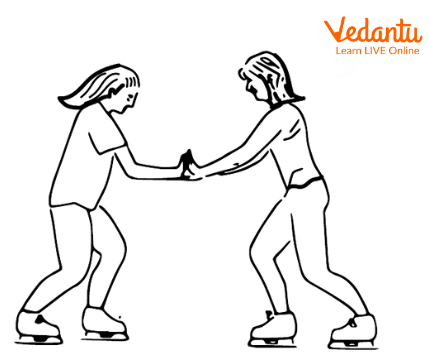




Let’s Learn About Newton’s Second Law of Motion for Kids
Newton's second law of motion for kids straightforwardly states that the rate of momentum is directly and proportional to the force applied to the object and takes place in the direction in which force is applied. The statement expresses that the acceleration of an item is subject to two factors - the net force acting on the object and the mass of the object. As the force applied to the article is increased, the speed increase(acceleration) of the item will also increase. As the mass of an object is increased, the speed increase(acceleration) of the item will decrease as it is inversely proportional to the mass.
Newton's Second Law For Kids
Newton's Second Law of Motion can be officially expressed as:
The speed or acceleration of an item depends upon the force acting on it and will increase if the force is increased and will decrease if the force is decreased. Similarly, the acceleration will decrease with an increase in mass and will increase with a decrease in mass.
a = F/m
where a = Acceleration
F = Total force acting on it
m = Mass
The above condition can also be written as the total force acting is equal to the product of mass and acceleration.
F = m × a
Here, the force is the total strength applied to the object. The acceleration is directly related to the net force; the net force rises when the mass is increased. The acceleration also increases with force. An acceleration is created by a net force. Recalling this difference is significant. As told above the acceleration takes place in the direction of the applied force which simply means that it is a vector quantity i.e. direction also changes with magnitude.
Steady with the above condition, a unit of force is equivalent to a unit of mass times a unit of acceleration. By substituting standard metric units for force, mass, and speed acceleration into the above condition, the accompanying unit equivalency can be composed.
1 Newton = 1 kg • m/s2
Newton’s Laws for kids
The meaning of the standard metric unit of force is expressed by the above condition. One Newton is characterized as how much force is expected to give a 1-kg mass an acceleration of 1 m/s2

Newton's First Law
An answer what are newton’s 3 laws for kids is given below:
The first law of movement expresses that: an item in rest will remain at rest until and unless an external force is applied to it.
For example, Your soccer ball won't move unless you kick it. When it's flying through the air, it will keep flying through the air except if it is dialled back via air obstruction, gravity's force (it tumbles to the ground), or your foot or body connecting with it.
The second law of movement expresses that: Acceleration happens when a force follows up on mass. The more prominent the mass, the more force is expected to cause acceleration. The harder you kick the soccer ball, the quicker it flies (speeds up). The bigger the soccer ball, the harder you should kick.
The third law of movement expresses that: for each activity, there is an equal and opposite response. At the point when you kick your soccer ball, it goes flying. As your foot returns, your body feels the force of the kick. You should move to keep your equilibrium. This is Newton’s third law definition for kids.

Newton’s Third Law
Summary
We have learnt what are Newton’s 3 laws for kids. And tells us how their components change concerning each other. This law has many practical implementations as well. It states that every action has an equal and opposite reaction. Let us take the second law of Newton, if a man pushes a loaded cart then he would need more force but if he pushes an empty cart he could do it using less force. This phenomenon is explained by the second law of motion that the heavier the mass, the more force is needed. Newton’s second law of motion for kids is explained very nicely in this article. Still, if you have any doubts feel free to ask in the comments.
FAQs on Newton’s Second Law for Kids
1. What is Newton's Second Law of Motion in simple terms for kids?
Newton's Second Law of Motion explains how things move when you push or pull them. It says that the harder you push something, the faster it will speed up, which is called acceleration. It also teaches us that heavier objects need a bigger push to move as fast as lighter objects.
2. How does Newton's Second Law explain why it's easier to push an empty shopping cart than a full one?
This is a perfect real-world example. The empty cart has less mass (it's lighter), while the full cart has more mass (it's heavier). According to Newton's Second Law, you need to apply more force (a bigger push) to make the heavy, full cart accelerate and start moving compared to the lighter, empty one.
3. Can you give some simple examples of Newton's Second Law in everyday life?
Yes, Newton's Second Law is at work all around us. Here are a few common examples:
- Kicking a football: Kicking the ball gently (less force) makes it move slowly. Kicking it hard (more force) makes it accelerate and fly much faster.
- Riding a bicycle: You must pedal harder (apply more force) to accelerate up a hill compared to riding on a flat road.
- Pushing a swing: A small, gentle push will only move the person on the swing a little. A big, strong push (more force) will make them accelerate and go much higher and faster.
4. What is the simple formula for Newton's Second Law?
The scientific formula for Newton's Second Law is Force = Mass × Acceleration (F = ma). For kids, it's easier to think of it this way: the amount of 'push' or 'pull' (Force) you need depends on how heavy an object is (Mass) and how quickly you want it to speed up (Acceleration).
5. Why does a cricketer pull their hands back while catching a fast cricket ball?
A cricketer does this to make the catch hurt less by using Newton's Second Law. The fast ball carries a lot of force. By pulling their hands back, the cricketer increases the amount of time it takes to stop the ball. Spreading the force out over a longer time reduces the impact on their hands and helps prevent injury.
6. If you stop pushing a toy car, it slows down and stops. Does this go against Newton's Second Law?
That's an excellent question, and it actually proves the law! When you stop pushing, another force called friction takes over. Friction is the invisible force between the toy car's wheels and the floor that acts against the motion. This force of friction causes the car to slow down (decelerate) and eventually stop.
7. What is the other name for Newton's Second Law of Motion?
Newton's Second Law of Motion is also commonly known as the Law of Acceleration. This is because it perfectly describes how the acceleration of an object is directly connected to the net force applied to it and its total mass.
8. What would happen if you kicked a small plastic ball and a heavy bowling ball with the same amount of force?
If you used the exact same kicking force on both, the small plastic ball would accelerate much more and fly away very fast because it has very little mass. The heavy bowling ball, which has a lot of mass, would barely move or might just roll a tiny bit. This demonstrates how for the same force, a lighter object accelerates more than a heavier one.









